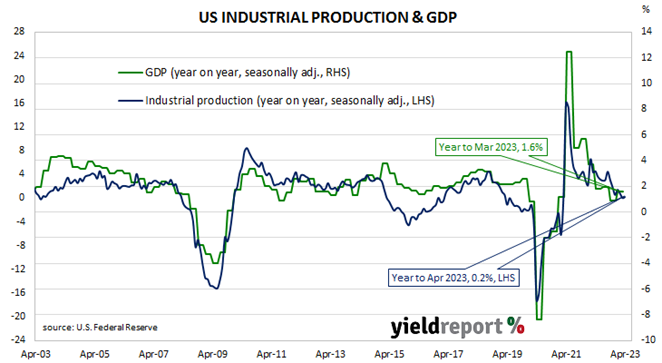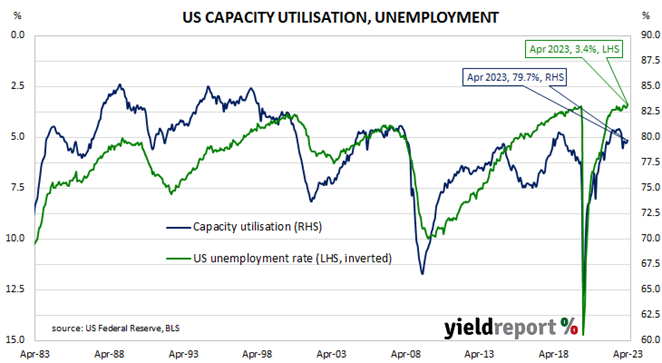Summary: US industrial output up 0.5% in April, above expectations; up 0.2% over past 12 months; manufacturing output up on vehicle production; Treasury yields rise, rate-cut expectations soften; capacity utilisation rate up 0.3ppts to 79.7%, just below long-term average.
The Federal Reserve’s industrial production (IP) index measures real output from manufacturing, mining, electricity and gas company facilities located in the United States. These sectors are thought to be sensitive to consumer demand and so some leading indicators of GDP use industrial production figures as a component. US production collapsed through March and April of 2020 before recovering the ground lost over the fifteen months to July 2021.
According to the Federal Reserve, US industrial production increased by 0.5% on a seasonally adjusted basis in April. The result was greater than the zero change which had been generally expected as well as March’s unchanged figure after it was revised down from 0.4%. On an annual basis the growth rate ticked up from March’s revised figure of 0.1% to 0.2%.
“Manufacturing output defied the softness in manufacturing indicators, rising 1% on strength in auto production, though revisions to recent months, means the April rise overstates the strength a little,” said NAB economist Taylor Nugent.
The figures came out the same morning as the latest retail sales figures and US Treasury bond yields rose on the day, especially at the short end of the yield curve. By the close of business, the 2-year Treasury yield had gained 7bps to 4.07%, the 10-year yield had added 4bps to 3.54% while the 30-year yield finished 2bps higher at 3.86%.
In terms of US Fed policy, expectations of a lower federal funds rate through the remainder of 2023 and into 2024 softened a little. At the close of business, contracts implied the effective federal funds rate would average 5.095% in June, essentially unchanged from the current spot rate, and then creep up a touch to an average of 5.105% in July. September futures contracts implied a 5.005% average effective federal funds rate while May 2024 contracts implied 3.75%, 133bps less than the current rate.
The same report includes US capacity utilisation figures which are generally accepted as an indicator of future investment expenditure and/or inflationary pressures. Capacity usage had hit a high for the last business cycle in early 2019 before it began a downtrend which ended with April 2020’s multi-decade low of 64.2%. April’s reading increased from March’s revised figure of 79.4% to 79.7%, just below the long-term average of 80.1%.
While the US utilisation rate’s correlation with the US jobless rate is solid, it is not as high as the comparable correlation in Australia.



